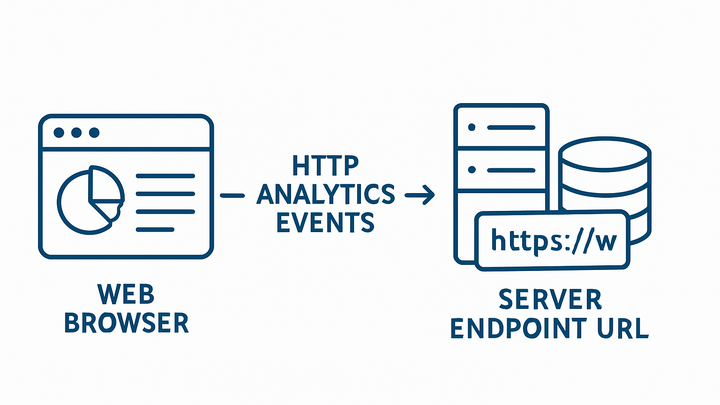Published on 2025-06-28T04:14:35Z
What is an Endpoint? Examples for Analytics Endpoints
An endpoint in analytics is the specific URL or URI where tracking data is sent for processing and storage. It acts as the receiving interface between your application (website or mobile app) and the analytics platform’s data pipeline. Whenever a user interacts with your site, analytics scripts or SDKs package events into HTTP requests and deliver them to this endpoint. Proper endpoint configuration ensures that every event—pageviews, clicks, or custom interactions—is accurately captured. Misconfigured or unreachable endpoints can lead to gaps in your analytics data, making it harder to make informed decisions. Endpoints can be implemented both on the client side (in the browser or mobile device) and the server side, each offering unique benefits for data reliability and privacy.
Endpoint
A URL where analytics event data is sent to be processed and stored by an analytics platform.
Definition and Role
Analytics endpoints serve as gateways that accept incoming event data and forward it to the analytics platform’s processing pipeline. They validate the payload, apply rate limiting, and ensure secure and reliable data ingestion.
-
What is an endpoint?
An endpoint is a specific URL exposed by an analytics service where event data is sent via HTTP requests. It defines the destination and protocol (usually HTTPS) for transmitting tracking data.
-
Role in data collection
Endpoints handle the reception, validation, and routing of analytics hits, ensuring that every interaction—in-browser or server-side—is captured and stored for analysis.
Types of Analytics Endpoints
Analytics endpoints can be implemented in multiple ways depending on where and how data is collected. The main categories are client-side and server-side endpoints, each with trade-offs in accuracy, privacy, and complexity.
-
Client-side endpoints
These endpoints are invoked directly from the user’s browser or mobile app using JavaScript or SDKs. They handle real-time user interactions like pageviews, clicks, and form submissions.
-
Cookie-based tracking
Relies on browser cookies or localStorage to identify sessions and users.
-
Cookie-free tracking
Uses alternative identifiers such as first-party storage or probabilistic methods, as seen in PlainSignal.
-
-
Server-side endpoints
Events are forwarded from your backend servers to the analytics platform, bypassing ad blockers and ensuring higher data reliability. Commonly used for sensitive events like transactions.
Examples in SaaS Products
Different analytics platforms expose distinct endpoints and embed methods. Below are examples from PlainSignal and GA4.
-
PlainSignal endpoint
PlainSignal is a cookie-free, simple analytics solution. By embedding its lightweight script, your site sends events to its endpoint. Example tracking code:
<link rel="preconnect" href="//eu.plainsignal.com/" crossorigin /> <script defer data-do="yourwebsitedomain.com" data-id="0GQV1xmtzQQ" data-api="//eu.plainsignal.com" src="//cdn.plainsignal.com/plainsignal-min.js"></script> -
Google analytics 4 (GA4) endpoint
GA4 provides its Measurement Protocol endpoint at
https://www.google-analytics.com/mp/collect. Data can be sent via thegtag.jslibrary or direct HTTP calls to this URL.
Best Practices for Analytics Endpoints
To maintain data integrity and performance, adhere to these best practices when configuring analytics endpoints.
-
Use https and secure headers
Always serve endpoints over HTTPS, and configure CORS and security headers to restrict origins and protect against malicious requests.
-
Validate and sanitize payloads
Check incoming event data for required fields and correct formatting. Implement server-side validation to prevent malformed or malicious payloads.
-
Monitor and scale
Track endpoint performance metrics like latency and error rates. Use autoscaling or load balancing to handle traffic spikes gracefully.
Troubleshooting Common Issues
When analytics data fails to appear, investigate these frequent endpoint-related problems.
-
Cors policies
Cross-origin restrictions can block browser requests. Ensure the endpoint’s response includes
Access-Control-Allow-Originwith your domain. -
Blocked by ad blockers
Endpoints using common analytics domains may be blocked. Use custom domains or subdirectories to reduce blocking rates.
-
Network errors and timeouts
Intermittent network issues can drop requests. Implement retry logic or switch to server-side tracking for critical events.
